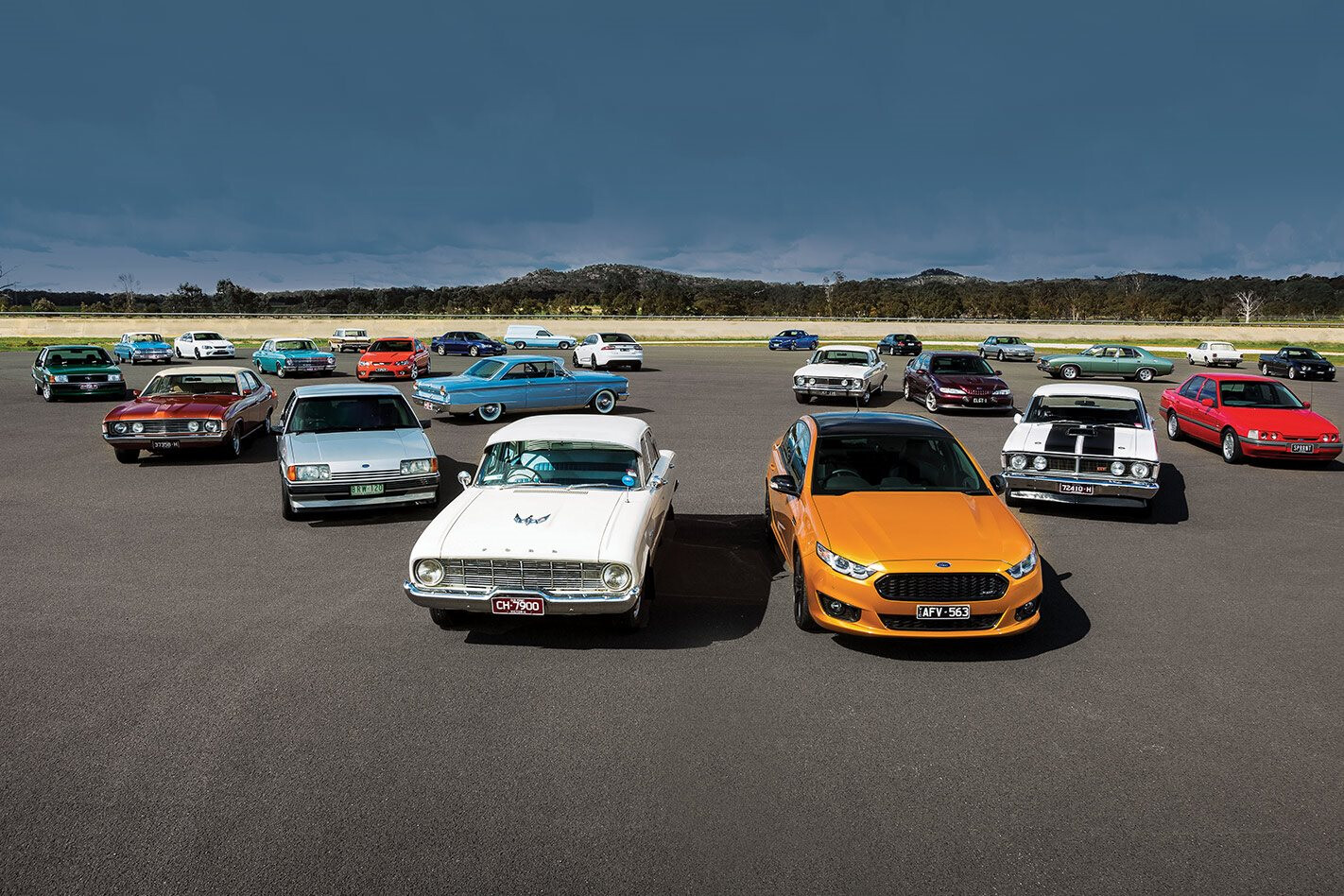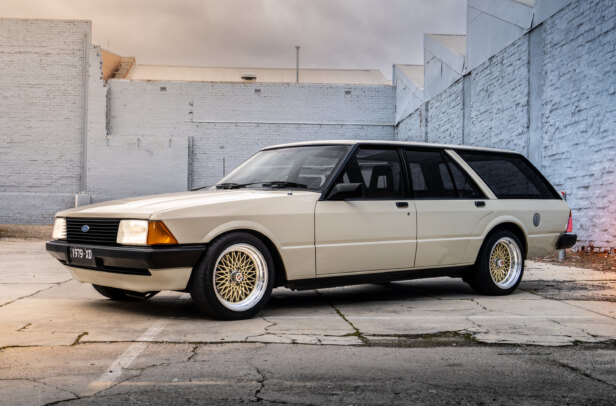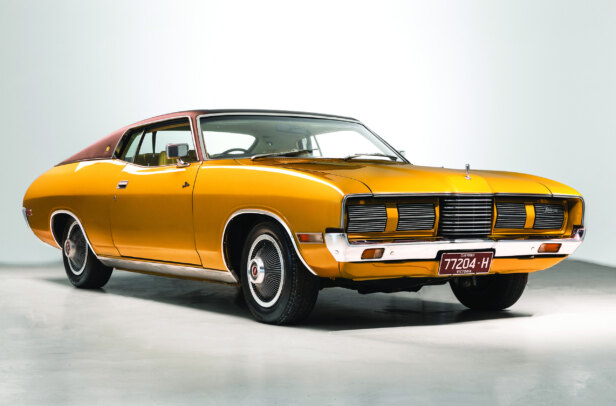AH, FORD Falcon! How we miss thee. You arrived in Australia as an American design, but you were soon adapted to local
conditions. And when the Yanks cruelly dropped you, we kept the dream alive with our own spin on the concept, growing in size and sophistication with each generation until Ford gave up on local manufacturing altogether in 2016.
Even so, you remain a vital part of Australian culture, and on your 60th anniversary we celebrate you – the highs, the lows and the creamy middles – from A to Z.
A is for Allan Moffat
ALLAN Moffat’s heroic solo Bathurst drive in 1970 was his first Mountain win, leading home Bruce McPhee for a 1-2. The following year Moffat repeated the feat in a Phase III – despite a Southwark Bitter carton smooshed against his grille – with Falcon drivers Barnes/Skelton and David McKay following for a crushing 1-2-3 against Holden.
Moffat conquered the Mountain twice more, most infamously in 1977 when teammate Colin Bond, on team orders, stayed behind Moff to stage their iconic formation finish.
B is for Barra
WHILE it’s tempting to hit Bill Bourke, father of the GT, for a double word score, or Broadmeadows, Ford’s Australian manufacturing hub, we’re going with Barra.
While it shared its bore centre measurements with the original 144ci wheeze-o-matic fitted to the XK of 1960, the Barra was a true grandpa’s axe. Twin cams, 4.0 litres, turbo options and, with some modifications, the ability to make 1000hp all prove that the architecture was sound. It’s Australia’s own 2JZ.
C is for Cobra
WHEN you’re Edsel Ford II and your job is to move a few hundred slow-selling coupe bodyshells, the solution is to paint them Bold Blue, then paint them Sno White and leave a couple of go-fast stripes. Helps if your mates Moffat and Bondy can orchestrate a 1-2 finish in the same XC-model body.
Cars numbered 002 to 031 received Option 97, including twin radiator fans, gearbox oil cooler, revised rear wheelarch wells and a horn bonnet scoop.
D is for Durability Run
WITH the Falcon’s initial success marred by ball-joint issues, the solution was to fit heavier, Fairlane-spec ball joints; but how to repair the Falcon’s reputation?
Henry Ford II greenlit the 70,000-mile Durability Run, believing it to be held on a smooth speed bowl. When he found out it wasn’t, he proclaimed, “Out of your minds! A bunch of damned fools,” and left in a helicopter. By 3 May 1965, five XP Falcons had saved the brand and set 49 endurance records.
E is for Easter 1972
PERHAPS the XD and XE Falcon ESP deserved a spot here, but nah. The Better Brakes 100, held at Bathurst over Easter 1972, is often lauded as one of the greatest touring car races in history.
The third round of the ATCC saw ‘Pete’ Geoghegan’s XY ‘Super Falcon’ GTHO duelling with Allan Moffat’s Mustang. After slipstreaming down Conrod Straight, broad daylight appearing under the cars as they crested the humps at over 170mph, Big Pete took the flag by just 6/10ths of a second.
F is for FTE and FPV
TICKFORD/FTE (Ford Tickford Experience; 1991-2002) handled engineering of the legendary XR6 and XR8, adding anniversary-edition GTs to the range in 1992 and 1997 respectively, along with specialist muscle cars such as the T-series during the AU era. FPV (Ford Performance Vehicles; 2002-2014) levelled up, bringing us the F6 Typhoon turbo, F6E, Force 6 and V8-powered Force 8 and GS, with the GT returning as a full-time model, reinforcing those two little letters as the pinnacle of Ford muscle.
G is for GT
WHEN product engineering supervisor Don Dunoon and racing driver Harry Firth developed an XR Falcon option pack for the Victorian police force, few could have predicted the outcome. After building eight, boss Bill Bourke suggested the GT pack; a premium sports sedan with an eye on Bathurst homologation.
GT versions of all models followed until the XC. After resting the name for 16 years, Tickford created two anniversary models before the GT returned as a regular production option via FPV with the BA and BF.
H is for Holden
A GREAT hero needs an arch-enemy, and Holden was the yin to Falcon’s yang – the dark to the light, if you will.
The Falcon’s release in 1960 brought a lower, sleeker, more modern family car, and with it, a wake-up call to Holden, whose stodgy EK sedan, finned and upright, belonged in the previous decade (below).
Bathurst-bred horsepower wars ensued, and although the battle was over in the showrooms when the Falcon bowed out in 2016, it will never abate so long as there are people like us.
I is for Sir Brian Inglis
SIR Brian was instrumental in Ford’s decision to build the US-designed Falcon rather than a warmed-over Zephyr. He was later
quoted as saying, “GM-H didn’t know what hit them”.
In 1970, Sir Brian became the first Australian-born managing director of Ford Australia and was knighted in 1977 for his services to industry and technology. He mentored Henry’s great grandson, Edsel Ford II, before retiring from the company in 1981.
Sir Brian, father of the Ford Falcon, passed away in 2014 aged 92.
J is for Tricky Dicky Johnson
THERE are drivers who have won more races than Dick Johnson, but it’s his plucky Bathurst attempts that forged him in Ford folklore.
The Falcon-loving privateer started second at Bathurst 1980, leading for the first 17 laps until he hit a footy-sized rock that had been booted onto the track. An impromptu telethon raised $72,000, with Edsel Ford II matching the figure. Johnson rewarded the faithful with a win in 1981, cementing his reputation as a lovable larrikin racer with immense skills both in the workshop and behind the wheel.
K is for KAG001, KAG002 and KAG003
THE XT Falcon GT is often remembered as the only 60s-era GT to never win Bathurst, but it did secure third (KAG002), sixth (KAG003) and eighth (KAG001) in the gruelling London-Sydney Marathon, held between 24 November and 17 December 1968.
After 7000 miles across 11 countries, competitors arrived at Bombay, India for a nine-day sea voyage to Perth, followed by a further 2600 miles to Sydney. A Hillman Hunter won the day, but the factory Falcons won the sought-after Teams Prize.
L is for Lowndesy
CRAIG Lowndes is one of the few drivers beloved by Holden and Ford fans alike, having won Bathurst four times in the former and three in the latter.
‘The Kid’ also stands as perhaps the only driver to have both Holden and Ford special editions named after him: the 2015 Holden Commodore SS-V Craig Lowndes Edition (233 built) and the 2007 Ford Falcon XR Ute by Craig Lowndes, available in XR6 (353 built), XR6 Turbo (100) and XR8 (197). That’s versatility!
M is for Mount Panorama (Wahluu), Bathurst
HOWARD Marsden or Allan Moffat could easily slip into this entry, but without the racetrack that made them legends, neither would qualify.
Running annually at the circuit from 1963, the Bathurst 500/1000 has had many names and hosted several categories. Falcon’s first win at the Mountain was by Harry Firth and Fred Gibson in an XR GT, with the Falcon going on to win 13 more times between 1970 and 2014.
N is for Nissan XFN ute
HAVE you ever seen an XF Falcon ute with Nissan badges and wandered away confused? Be confused no longer, because the Nissan Ute was a result of the same model-sharing agreement that gave us the Ford Maverick (Nissan Patrol) and Ford Corsair (Nissan Pintara).
It’s obvious Nissan drew the short straw; the XF Falcon was more Ford than Henry himself. Those that did buy them could pull the Nissan badge off the grille and find the aperture ready and waiting for a Blue Oval.
O is for Off-Road
FOR those that like their Falcons cooked rare, try a taste of the XY Falcon 4×4. Borne of a need nobody remembers, just 432 were laboriously hand-assembled at Ford’s Eagle Farm facility in Queensland, alongside low-volume RHD F-trucks.
Willys supplied the front axles, which bent in testing, causing supply delays that resulted in a 1972 release – after the launch of the smooth and sleek XA Falcon and the introduction of a bunch of ADRs the 4×4 had to comply with. Cooked indeed!
P is for Phase IV
A DEALER bulletin detailing the Falcon GT’s new ‘Handling Option’ was an innocuous beginning for the mighty XW GTHO Phase I. With more power and stronger components, the XW Phase II and XY Phase III followed in quick succession, garnering Bathurst wins for Allan Moffat in 1970 and ’71.
The sleeker, lower XA Falcon GTHO Phase IV promised even more, but an article in Sydney’s Sun-Herald stopped development cold. The 1972 ‘Supercar Scare’ saw the Phase IV bow out with just four cars built: one production sedan in Calypso Green and three race cars in Brambles Red.
Q is for Queensland
GEELONG, Broadmeadows and Homebush are synonymous with Ford Australia, but the flexibility of Brisbane’s Eagle Farm plant was integral to Falcon’s success. The Queensland factory added to Falcon production numbers from July 1960 and handled the fiddly hand-assembly required of the XY Falcon 4×4 in 1972.
Although Falcon production ceased in Brisbane in 1976, it continued to build the Fairlane/LTD twins through to 1987 before becoming a specialist truck assembly facility until it closed in 1998.
R is for R-Code Bill Bourke Special
OKAY, so it wasn’t officially stamped with an R-code plate; Bill Bourke’s car was a 351ci V8 to begin with, and was stamped as such. But the former managing director’s 428ci Cobra Jet-powered XW Falcon still stands as the only ‘factory-built’ big-block Falcon.
A hoon at heart, Bourke’s unique Falcon was tricked out in the USA, with Dearborn fitting a wind-back sunroof, flush-locking bonnet pins, American Racing wheels, high-back seats and that monstrous 7.0-litre V8 that regularly saw him hit 225km/h with four blokes on board.
S is for Sundowner
PANEL vans are cool. They’re like a car, but because you can root in them, they became the bedroom of choice for randy 1980s Aussie teens. Ford’s XC and XD Sundowner did not replicate the Holden Sandman’s wild success, nor did its predecessor, the XB Falcon Surfsider. Part of the Ford Leisure Range, the Surfsider van featured a front-hinged fibreglass pop-top made by a boat shop in Capalaba. Enclosed by canvas awnings, it theoretically allowed someone to stand upright, even if they couldn’t walk anywhere once they were.
T is for Turbo
ONCE Ford killed off the V8 in 1982, aftermarket tuners went to town turbocharging the Falcon six. But it took another 20 years for the factory to commit to forced induction. It was worth the wait, with the BA Falcon XR6 Turbo making a decent 240kW, with plenty more in wait with some bolt-ons and tuning.
FPV’s F6 Typhoon/Tornado turned the wick up to 270kW, but this was nothing compared to the final edition FG-X XR6 Turbo Sprint, which smashed out a prodigious 325kW out of the box.
U is for ute
FORD Australia essentially invented the ute, so it stands to reason that the Falcon would feature this variant almost from the get-go. After neglecting the hay hauler through the EA-EL series – instead continuing the previous-shape XF as the XG, XH and XHII – the workhorse returned reinvigorated for the AU, with a separate tub and cab-chassis options.
Sure, by 2007 the General’s ute had IRS and handled like a huge sports car, but that didn’t matter, because a cart-sprung, 270kW FG-X XR6 ute is infinitely entertaining.
V is for V8
FORD’S 1967 introduction of the 289ci Windsor V8 sparked a power war with Holden that still rages today. When the XA rocked up, the Windsor was replaced by the Cleveland, with 302 and 351 capacities offered until Ford discontinued all V8s in 1982. Holden’s strong V8 sales forced a rethink and the 5.0-litre Windsor returned in 1991. FTE stroked the old donk to 5.6 litres in the AU; the BA offered the 5.4-litre, quad-cam Boss; and the FG-X XR8 Sprint finished on a high with the blown 335kW Miami 5.0-litre.
W is for Wheels Car of the Year
THE Falcon won Wheels magazine’s COTY award with the XP (1965), XR (1966) and BA (2002), yet the 36-year gap doesn’t tell the whole story. Despite the general assumption that the XA would win in 1972, Wheels withheld the award completely, repeating the slight in 1979.
Although Ford spent $100 million developing the XD Falcon, the carry-over leaf-sprung rear suspension was a bugbear. Wheels published their infamous ‘lemon’ cover, with editor Peter Robinson sending a framed copy to Edsel Ford II, who hung it in his toilet.
X is for XR6 and XR8
THE XF and EA models were a dark period for Falcon fanatics; the V8 was gone. But July 1991 heralded the bent-eight’s triumphant return in the S-XR8, with the S-XR6 added the following year.
Dropping the ‘S’ for the ED series, the XR6 and XR8 became mainstays of Ford’s performance range throughout the remainder of the Falcon’s illustrious life. Fast-forward to the final FG-X model and the XR6 and XR8 Sprint versions became some of the fastest, baddest, most awesome Aussie muscle cars ever.
Y is for You Yangs
WHEN Henry Ford II queried why the XK Falcons suffered ball joint failures, Sir Brian Inglis reported that Ford Australia had no test facility and instead relied on data from the USA. Henry II responded, “I’ll give you a test track; don’t ever come back to me again with a durability problem.” Nobody told him about the XD door handles, then.
The Lara Proving Ground, nestled in the You Yangs near Geelong, was purchased in 1964 and now includes research facilities, a skidpan, durability track and high-speed test loop.
Z is for Zephyr
FORD Australia had every intention of pitting a facelifted Mark II Zephyr against Holden, with managing director Charlie Smith and team flying to Detroit to review the final clays. While there, they spotted Ford USA’s new ‘compact’ Falcon. Lighter, cheaper to build and infinitely more modern, Smith told his superiors: “That’s the car I want for Australia.”
Although it cost £137,000 to cancel the Zephyr, Ford retooled for the Falcon, converted Geelong into an engine plant and established a chassis plant. Smith retired in 1959, having saved Ford Australia.




Comments